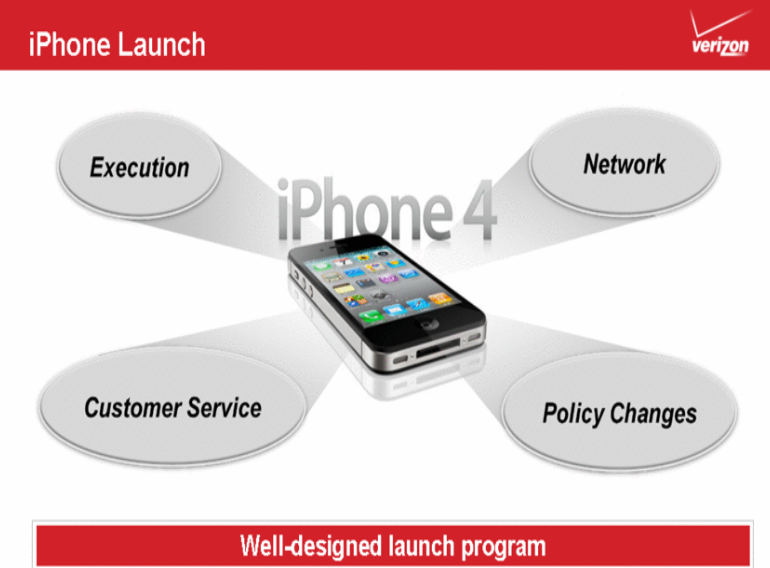Verizon: How iPhone, LTE Droids will affect network, financials, big picture

Lowell McAdam, Verizon president and chief operating officer, said that 50 percent of the company's devices will be smartphones by the end of 2011, roughly double today's percentage. Why? Apple's iPhone and Android devices running on Verizon's 4G network.
Verizon executives on Tuesday moved to address a bevy of moving parts with the iPhone and the impact on the carrier's business. McAdam indicated that he expects the iPhone to have "its own gravitational pull," but Android will remain hot. "We won't be a one phone company," he said.
McAdam said the company has doubled its 3G wireless capacity every year and just finished bulking up again for the launch of Apple's iPhone. McAdam also said that Verizon will "double LTE coverage" in 2011 and "blanket the country by 2013."
Also: Verizon's fourth quarter earnings fall short, but wireless subscribers surge
And then there's the financial part of the iPhone equation. Verizon has tweaked policies, ramped up customer support and bolstered the network to handle the iPhone.
The message from McAdam and Verizon CFO Fran Shammo: We're ready for the iPhone and the network is prepped for a bevy of new revenue streams. More importantly---at least to the Wall Street analysts in the room---Verizon argued it can maintain profit margins in the 47 percent range despite the launch of the iPhone. There had been a lot of concern that the iPhone would kill Verizon's profit margins.
Verizon's dance to balance the iPhone financial hit with its bottom line will have some customer impact. Among the key items:
- Verizon Wireless will ditch its "every two" promotion where you can renew a two-year contract and get a credit.
- The return policy will change from 30 days to 14.
- There will be a new trade-in effort via a third party so you can turn in phones early.
- Verizon will have a $30 unlimited data plan for the iPhone.
Overall, McAdam and Shammo were reticent to get into iPhone projections too much. After all, Verizon executives didn't have a lot of clarity on how iPhone demand would shake out. Shammo, using the consensus view that Verizon will sell about 11 million iPhones in 2011, said that Verizon is looking for 4 percent to 5 percent revenue growth in 2011, up from 1.9 percent growth in 2010. Shammo said that Verizon will maintain profit margins in the 47 percent range. Earnings will be up 5 percent to 8 percent in 2011. The biggest wild-cards with projecting iPhone sales at Verzion are supply, upgrades from customers and how the subsidy to Apple hits the bottom line.
One area where Verizon was confident: Its network. McAdam said that 3G remains an important cog in the network machinery. "The 3G network has been and will continue to be important," he said. "3G will be important beyond 2011."
Meanwhile, Verizon's LTE network buildout will continue.
Verizon execs were quick to note that the company's master plan moved well beyond wireless. Wireless is important, but Verizon sees it as a key cog into an any content-any device-everywhere strategy.
In a graphic, here's how Verizon sees it all coming together.
Among the key parts.
- The company has been investing in FiOS, MCI and Alltel while divesting less profitable assets. "This asset base gives us a foothold in key growth areas," he said. "I feel good about the competitive position as we look forward."
- McAdam's strategic case is that Verizon is well positioned for an economic upturn. Verizon is increasingly a wireless company and customers expect to be connected any time on any device.
- Verizon's network capability will allow it to keep up with video demand over its network.
- McAdam spent a lot of time talking about how Verizon's network is positioned for cloud services and reaching the enterprise.
- He added that the end of the FiOS build should reach 18 million premises. So far, 15.6 million premises are passed to date. McAdam said the throughput on FiOS was upped to 150 Mbps. "Our focus is on driving that investment to deliver greater returns," said McAdam. "I think it can generate much higher margins going forward."
- FiOS can be broadened into other services throughout the home. "The fiber connected home can manage your digital life," said McAdam. He sees security, energy monitoring and other add-on services as a diversification tool.
